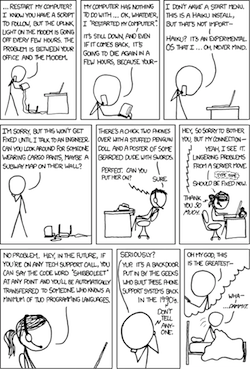Reading Web Comics via Bash Script

I follow several Web comics. I used to open my Web browser and check out each comic's Web site. That method was fine when I read only a few Web comics, but it became a pain to stay current when I followed more than about ten comics. These days, I read around 20 Web comics. It takes a lot of time to open each Web site separately just to read a Web comic. I could bookmark the Web comics, but I figured there had to be a better way—a simpler way for me to read all of my Web comics at once.

So, I've written a Bash script that I point at any of my favorite Web comics. The script is pretty straightforward: it downloads the Web comic's Web page, then looks at every image on the page and tries to figure out which one is the comic.
Let me first tell you about three important tools I use in this script:
- You already may be familiar with the first one: wget will download files from the Web, using http or https.
-
The second tool is ImageMagick. It's really a set of command-line tools
that manipulate images. You can do a lot with ImageMagick, but in
this script, I focus on two key features:
identifyto get attributes about an image andconvertto transform an image from one format to another. - The other tool was new to me: xmllint. Part of the Libxml project, you can use xmllint to query an XML or HTML document and retrieve data from it. I could write a lot about xmllint. Like any useful tool, you can leverage xmllint to do a bunch of different things. Programmers might use xmllint to parse an XML document for a particular value, such as a success value in a Web services system. But in this Bash script, I use xmllint to print specific tags from an HTML document. Your system already should have xmllint installed; it's a standard package in just about every Linux distribution.
I'm assuming you already are familiar with standard UNIX command-line tools, including head and awk.
With these tools, you can build a Bash script to fetch a Web comic from a Web page and save it to view later. The process involves five simple steps:
- Download the Web comic's Web page and convert relative links to absolute links (wget).
- Find every image referenced in the Web page (xmllint).
- Download those images (wget).
- Find the largest image (identify).
- Convert that image for later viewing (convert).
The core assumption is the Web comic will be the largest image (by dimension) on the Web page. This is usually true. When you account for the Web site's logo, icons for social media and other decorations, the Web comic is usually the largest image on the page. But sometimes artists will share other media on their Web sites, such as conference photos or fan artwork. Those secondary images might be larger than the Web comic. In this case, the Bash script will fetch one of the secondary images instead of the Web comic, so your mileage may vary, depending on the Web site. But in most cases, this assumption works fine.
One problem in automating this process is you never know how the Web
site will be coded. Image tags might use double-quotes or
single-quotes. Or images might use src= and alt= in
a different
order. Some Web sites might use spaces or other odd characters in the
image filenames. Fortunately, all of this is made easier using
xmllint. No matter the input, xmllint will return data using
double-quotes and with spaces escaped via HTML. This is a default
feature of xmllint; you don't need to call any command-line options to
sanitize xmllint's output.
Let's go through the process step by step:
The first step, downloading the Web page and converting links to absolute links, is easily done using wget. There's a handy command-line option to convert links automatically:
wget --convert-links -O /tmp/index.html https://www.example.com/comic/
This fetches the Web page and saves it as /tmp/index.html. After the download is complete, wget converts links, so an image referenced as /images/comic.png will be converted to something like https://www.example.com/images/comic.png.
Once you have a local copy of the Web page, you can use the power of xmllint to pull only the images from the document. There are many ways to use xmllint. The key is to specify an Xpath expression. An Xpath is the standard syntax to interact with an XML or HTML document, using expressions to identify only the parts of the document that you want. In this case, you're interested in the images referenced in the document. Remember that the standard syntax for an image tag in an HTML document looks like this:
<img src="/images/comic.png" alt="Today's comic" />
The image tag can appear anywhere in the HTML document, and the Xpath
to pull any <img> tag no matter its location is with the
//img
expression:
xmllint --html --xpath '//img' /tmp/index.html
But specifically, you want the src= part of the image tag. You can do
this very easily by extending the Xpath expression. In an Xpath, @
selects an attribute. So to fetch the src= attributes for all
<img>
tags in the document, you modify the Xpath expression in your xmllint
command:
xmllint --html --xpath '//img/@src' /tmp/index.html
Ideally, I'd fetch only the values of the src= attributes, but I
don't know of a way to do that via a single Xpath expression. The
output of this xmllint command is a single line, listing every
src=
attribute for every image referenced in the HTML page. So you'll get
something like this:
src="https://www.example.com/logo.png"
↪src="https://www.example.com/i/comic.png"
Conveniently, the image links always will be absolute links, because
that's how wget converted the Web page. The key in the output is the
use of double-quotes around each image src= reference. Remember that
xmllint always returns data using double-quotes, even if the input
used single-quotes. With this assumption, the fix is easy. A quick
pass through awk returns a list of images: use the double-quote as a
field separator and look at every other field.
xmllint --html --xpath '//img/@src' /tmp/index.html |
↪awk -F\" '{for (i=2; i<NF; i+=2) {print $i}}'
From there, it's a matter of fetching each image in turn and figuring
out how large each image is. The identify command from ImageMagick
helps here. You can instruct ImageMagick to print the image
dimensions in a format that Bash can evaluate as an arithmetic
expression:
identify -format '%W * %H\n' /tmp/comic.png
The output from identify prints the width and height, which you can
ask Bash to calculate (1024 * 539 evaluates to 551,936, for
example). For a list of images, you calculate the size of each and use
sort to find the largest one. The core assumption is the Web comic
will be the largest image (by dimension) on the Web page, so that's
the one you copy for later use.
With these parts, you can assemble the final Bash script to fetch Web comics. The command line for this script provides the URL and the name of the local copy of the Web comic file, which is saved in JPEG format:
#!/bin/bash
# Usage: fetch-comic.sh URL Name
if [ $# -ne 2 ] ; then
echo 'Usage: fetch-comic.sh URL Name'
exit 1
fi
URL=$1
NAME=$2
TMPDIR=$HOME/tmp
TMPFILE=$TMPDIR/index.tmp
CACHEDIR=/var/www/html/comics
USERAGENT='Mozilla/5.0 (X11; Linux x86_64) AppleWebKit/537.36
↪(KHTML, like Gecko) Chrome/49.0.2623.112 Safari/537.36'
# fetch web page
wget --timeout=60 --user-agent="$USERAGENT" --convert-links
↪--quiet -O $TMPFILE $URL
# list images
# Since xmllint is (surprise!) a linter, it will squawk
# about the inevitable garbage in your html stream.
# We direct the stderr to /dev/null in the usual way:
images=$( xmllint --html --xpath '//img/@src' $TMPFILE 2>/dev/null
↪| awk -F\" '{for (i=2; i<NF; i+=2) {print $i}}' )
# find biggest image
imgcount=0
maximg=$(
( for imgURL in $images ; do
wget --timeout=60 --user-agent="$USERAGENT" --quiet
↪--referer=$URL -O $TMPDIR/$imgcount $imgURL
echo $(( $( identify -format '%W * %H\n' $TMPDIR/$imgcount
↪| head --lines=1 ) )) $TMPDIR/$imgcount
imgcount=$(( imgcount + 1 ))
done
) | sort -n -r | awk 'NR==1 {print $2}'
)
# convert the image
if [ $( file --mime-type --brief $maximg ) = 'image/gif' ] ; then
# convert GIF to JPG
convert "$maximg[0]" -resize 740\> $CACHEDIR/$NAME.jpg
else
# convert to JPG
convert $maximg -resize 740\> $CACHEDIR/$NAME.jpg
fi
I've had to add a few extra features to the Bash script, mostly to
accommodate animated GIF images. If you ask ImageMagick's
identify
utility for the dimensions of an animated GIF, it returns a
separate entry for every frame in the animation. So in the loop, I
limit the image size calculation to the first frame. Similarly,
ImageMagick's convert tool to transform an animated GIF to JPEG format
generates a separate image for every animation frame. I added an
if statement at the end to reference only the first frame for GIF
images.
To make local viewing easier, I use a special option to convert that
limits the new image to a maximum width of 740 pixels. If the input is
wider than that, the whole image is scaled down appropriately. Smaller
images are not resized.
I run this Bash script every morning via cron on a personal server in my house. The images are copied to the /comics directory on my Web server. I wrote a simple static Web page to display the Web comic images.
So as I start my day, I just open my Web browser to that local Web page and read all my Web comics at once. It's a big time-saver. Rather than visit 20 different Web sites to get my daily dose of Web comics, I use a simple Bash script to automate the work for me. Like any good programmer, I've gone through a little extra effort up front to make the rest of my day a lot easier—even if it's just for Web comics.









